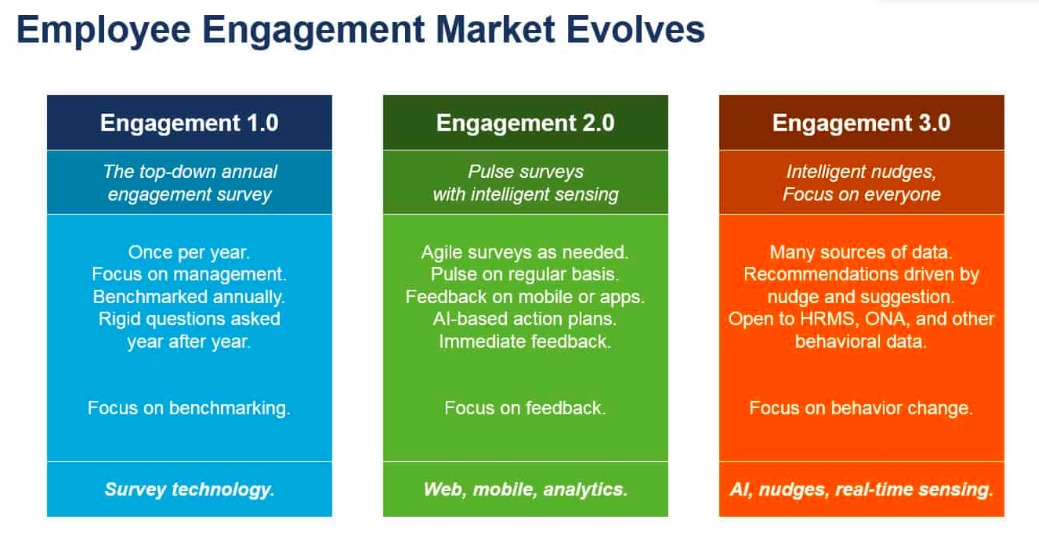Engagement 3.0? SWOOP has you covered
We were intrigued and somewhat excited when we saw HR guru Josh Bergin’s take on the evolution of the Employee Engagement marketplace. Bergin is an internationally renowned HR, People and Talent analyst, who recently provided his Top 5 Digital trends in HR. His take on the Employee Engagement market evolution is presented in the table above.
As SWOOP is a ‘reality mining’ tool that draws its data from staff digital interactions, we have not really showed much interest in survey-based approaches to employee engagement. But when we saw Bergin’s graphic and predictions for Engagement 3.0, it looks like our worlds have now intersected.
SWOOP and Engagement 3.0
As we read down the dot points for Engagement 3.0 we ticked them off as follows:
Intelligent Nudges, Focus on Everyone
Recommendations driven by Nudge & Suggestion
Nudges are just being implemented on the SWOOP platform now. Nudges will be provided to everyone on their SWOOP personal tab. Notifications initially will be administered through the community managers or platform administrators.
The science behind our nudges is a category of Artificial Intelligence known as ‘Knowledge Based Systems’. Knowledge Based (Expert) Systems were the cornerstone of the first wave of AI in the 1980/90s. These systems are inherently able to explain the logic behind their recommendations, something current AI machine learning is struggling with. SWOOP is building a rule engine to manage nudge rules that have been drawn from our extensive benchmarking activities. In the longer term we hope to take advantage of the transparency behind our ‘nudges’ to make this knowledge base open to our clients, so they can develop and add their own context specific rules.
Many Sources of Data
Currently SWOOP draws from Microsoft Yammer and Workplace by Facebook. In development are connectors for Microsoft Teams and Slack. Our strategy is to connect to as many digital sources that capture staff digital interactions as possible. Microsoft with O365 is ubiquitous. A maturing suite of APIs that access Microsoft’s products through the underlying Microsoft Graph structure will provide SWOOP with increasing access to the O365 suite including Sharepoint, Outlook, Kaizala etc. Outside of Microsoft, Workplace and Slack are the most likely complementary platforms that enterprises are implementing at volume.
Open to HRMS, ONA and other Behavioural Data
Organisational Network Analysis (ONA) is the foundation science underpinning SWOOP. The SWOOP principals bring decades of practical experience applying ONA to global organisations using survey methods, prior to developing SWOOP to capture ONA data from direct digital interactions. Behavioural personas drawn from personal interaction patterns have been adapted for online use and have become the most popular feature for influencing leaders’ online behaviours.
SWOOP uses Human Resource Management Systems (HRMS) data to identify each staff member’s profile e.g. position, role, location etc within the formal organisation chart. SWOOP uses this data to identify how staff are interacting across the formal lines of business. This function can be also be used to identify how different categories of staff e.g. job role, management level, gender, geographic location are actually interacting. It is only limited by the profiling data provided by the HRMS and/or related directory data.
SWOOP data has been used to study fundamental enterprise issues like gender diversity and inclusion and human performance. SWOOP provided analyses on cross gender interactions to Stanford University and co-authored a publication aimed at establishing an international standard for the collection of organisational interaction data. Griffith University in Australia used SWOOP data to identify the interaction profiles of their best performing students in their online post graduate studies program. They found the highest performing students aligned with the most constructive behavioural persona (Engagers) identified by SWOOP.
Focus on Behavioural Change
SWOOP uses AI sentiment analysis to assist organisations get a read on evolving sentiment in the organisation in real time. Organisational leaders can get a quick read on movements in organisational sentiment at all levels within the organisation.
By combining sentiment data with other SWOOP online measures of Reciprocity, Diversity and Curiosity we have been exploring the ability to uncover the different sub-cultures that exist within all organisations. Clashing sub-cultures are arguably the biggest barrier to effective organisation-wide collaboration. Through their identification we aim to provide organisational leaders with the data from which they can target the effective cultural changes they are looking for. Research results to date have been encouraging. We have been able to validate with selected organisations that our inferred sub-cultures aligned with the formal organisation are indeed accurate. The graphic below provides an example of culture maps using SWOOP measures of Sentiment, Reciprocity, Curiosity and Diversity for internal business units from one of our research clients. Read about our advice to Boards of Directors here.
At SWOOP, we aim to understand how our real-time interaction signals can be used to interpret behaviours and workplace climates. In our most recent work with online Teams we are looking to characterise the psychological safety that does or does not exist in digital team environments. We have recently benchmarked some 1,300+ self-nominated teams using the Workplace by Facebook platform. SWOOP measures, aligned with team performance factors identified through decades of academic research, were used to rate online teams.
AI, Nudges, Real Time Sensing
In summary, SWOOP is a real-time monitoring platform that gains its insights by studying how enterprise staff relationships are developed though digital interactions. We use AI technology like Sentiment Analysis to help profile individual, group and enterprise level behaviours and cultures. We use Knowledge Based Systems to develop nudges based on rules derived from our extensive benchmarking activities.
The SWOOP principals have grown through their own Engagement 1.0 and Engagement 2.0 experiences in applying Organisational Network Analysis techniques using various survey techniques to gather organisational data. In 2014, SWOOP was formed to take our insights into the realm of real-time sensing and to what Josh Bershin has labelled Enterprise 3.0; a label we are now happy to adopt to describe what we do. Thank you Josh!





